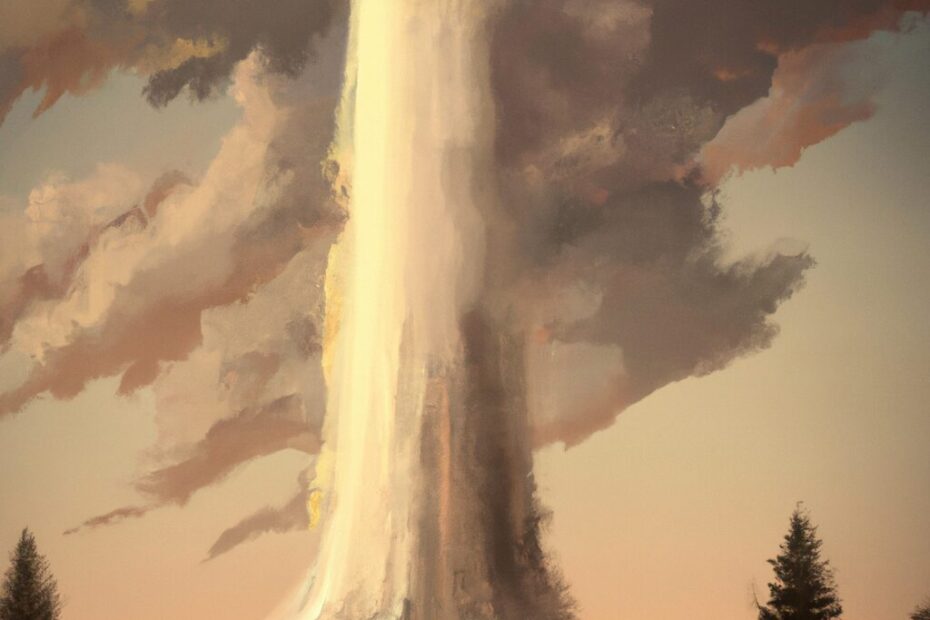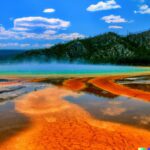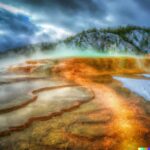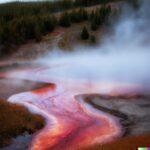Old Faithful Geyser, located in Yellowstone National Park, is one of the most famous and iconic geysers in the world. Discovered in the early 19th century, it has a rich history that includes Native American legends, early explorations, and scientific studies.
Known for its predictability and impressive eruptions, Old Faithful is a unique natural wonder that continues to captivate visitors from around the globe. In this article, we will explore the fascinating history, eruption process, and current state of this extraordinary geyser.
What Is Old Faithful Geyser?
Old Faithful Geyser, located in Yellowstone National Park, is a renowned geothermal landmark known for its predictable and impressive eruptions.
It is one of the most predictable geysers in the world, with eruptions occurring approximately every 90 minutes. This reliability has made it a popular attraction for visitors, who gather in anticipation of witnessing its powerful display.
The geological significance of Old Faithful lies in its connection to the volcanic activity beneath the Earth’s surface, where heated water rises from deep within the Earth’s crust to produce the iconic eruptions. Its consistent eruption cycle provides researchers and scientists with valuable insights into the geothermal phenomena that shape our planet.
Where Is Old Faithful Geyser Located?
Old Faithful Geyser is situated within the boundaries of Yellowstone National Park, captivating visitors with its mesmerizing geothermal features and iconic status as a tourist attraction.
The geyser is located in the Upper Geyser Basin, a renowned area of Yellowstone famous for its hot springs and hydrothermal features.
Its predictable eruptions, shooting water up to 100 feet in the air, draw throngs of tourists who gather around to witness this natural spectacle. The surrounding landscape, dominated by colorful mineral deposits and steaming vents, adds to the allure. Visitors are also fascinated by the scientific explanation of the geyser’s eruptions, making it an educational experience as well as a visual marvel.
When Was Old Faithful Geyser Discovered?
The mesmerizing geological phenomenon of Old Faithful Geyser was discovered during the early explorations of Yellowstone National Park, capturing the attention of those seeking to understand its natural wonder and significance.
Over time, the discovery of Old Faithful Geyser has played a pivotal role in shaping our understanding of the Earth’s geothermal activity.
Its consistent and awe-inspiring eruptions have fascinated geologists and researchers, shedding light on the complexities of volcanic systems and hydrothermal processes.
The geyser’s regularity has also allowed scientists to conduct in-depth studies in predicting its eruptions, leading to valuable insights into volcanic behavior and contributing to the advancement of geological research.
What Is the History of Old Faithful Geyser?
Old Faithful Geyser boasts a fascinating history intertwined with the geological processes that govern its eruptions, captivating the curiosity of visitors and researchers alike with its mesmerizing displays of steam, pressure, and eruptive intervals.
Native American Legends
Native American legends surrounding Old Faithful Geyser reflect its deep-rooted geological significance and the enduring natural history that has shaped the narratives of the indigenous communities in the region.
These stories speak of a deep respect for the powerful forces of nature, with the geyser often portrayed as a symbol of renewal and vitality. According to tradition, Old Faithful is seen as a link between the physical world and the spiritual realm, with its eruptions carrying both physical and metaphysical significance. Such narratives not only emphasize the cultural importance of the geyser but also provide valuable insights into the geological knowledge and spiritual connections of the Native American communities with the natural landscape.
Early Explorations
The early explorations of Old Faithful Geyser marked the commencement of scientific studies focused on unraveling the complex geological processes and geothermal dynamics underlying its mesmerizing eruptions.
These early investigations shed light on the intricate workings of geysers, foreshadowing the pivotal role they would play in shaping our understanding of geothermal phenomena. By delving into the rhythmic patterns of its eruptions and the underlying thermal features, researchers gained valuable insights into the broader geophysical mechanisms at play.
Their discoveries paved the way for further explorations that continue to enhance our knowledge of earth’s internal processes and the dynamic forces shaping our planet’s geology.
Naming of Old Faithful
The naming of Old Faithful Geyser originated from its remarkable and consistent eruptions, serving as a testament to the geological explanation and natural wonder it embodies within Yellowstone National Park.
The name ‘Old Faithful’ perfectly encapsulates the unwavering reliability of this iconic geyser. Its eruptions occur approximately every 90 minutes, mesmerizing visitors since it was named in 1870. Geologists credit this predictability to an underground system of chambers and conduits that channel hot water to the surface.
This mesmerizing display has captivated millions of tourists annually, standing as a symbol of the enduring marvels of nature. Witnessing its spectacular eruptions is a must for any visitor, showcasing the power and beauty of this natural wonder.
Early Scientific Studies
The early scientific studies of Old Faithful Geyser laid the foundation for understanding the intricate geological processes and geothermal dynamics that govern its awe-inspiring eruptions, paving the way for further research and exploration.
These studies provided valuable insight into the underlying mechanisms that drive the periodic eruptions of Old Faithful, offering a glimpse into the complex interplay of underground water reservoirs, hydrothermal features, and heat sources.
By analyzing the chemical composition and isotopic signatures of the geyser’s water, scientists began to unravel the deep-seated geological forces at play, shedding light on the broader context of geothermal activity in the region. Such pioneering research set the stage for a deeper comprehension of the geyser’s behavior and its significance in geothermal studies.
How Does Old Faithful Geyser Erupt?
The mesmerizing eruptions of Old Faithful Geyser are governed by a complex underground plumbing system, intricately linked to the geothermal features and geologic environment that define its unique eruption cycle.
This underground plumbing system comprises a network of fractured rock, cavities, and conduits. These allow pressurized water and steam from deep within the Earth to ascend and build up tremendous energy before being released in the iconic eruptions.
The geothermal features, such as the heat source from magma beneath the surface, contribute to the boiling and pressurization of water. The geologic environment, including the presence of faults and fractures, influences the pathways and timings of these eruptions, creating the awe-inspiring spectacle that has captivated visitors for generations.
Underground Plumbing System
The underground plumbing system of Old Faithful Geyser plays a pivotal role in the build-up of pressure and the subsequent mesmerizing eruptions that epitomize its geothermal characteristics and distinct geological phenomena.
This intricate network of channels and chambers beneath the earth’s surface facilitates the movement of superheated water and steam, creating the ideal conditions for pressure to accumulate over time.
As the geothermal dynamics come into play, the intense heat from the Earth’s mantle heats the water, propelling it upward through the plumbing system. The gradual build-up of pressure within these underground pathways culminates in the awe-inspiring eruptions that captivate visitors and researchers alike.
Factors Affecting Eruption
Several factors, including the interval, duration, and temperature fluctuations, influence the mesmerizing eruption of Old Faithful Geyser, reflecting the intricate link between its geology and the characteristics of geysers in the region.
These factors play a crucial role in shaping the spectacle that visitors eagerly await. The interval between eruptions directly correlates with the volume of water accumulated in the underground reservoir. Meanwhile, the duration and temperature variations are indicative of the underlying thermal activity. Understanding these elements provides insight into the broader geology and dynamics of geysers, enhancing our appreciation of nature’s remarkable displays.
What Makes Old Faithful Geyser Unique?
The unique qualities of Old Faithful Geyser stem from its remarkable predictability, impressive duration and height of eruptions, and the frequency with which it captivates visitors with its awe-inspiring displays.
Old Faithful Geyser is a popular attraction in Yellowstone National Park, known for its reliable eruptions that occur every 90 minutes. This predictability adds to the excitement and anticipation for visitors. The eruptions last between 1.5 to 5 minutes and can reach heights of up to 180 feet, creating a stunning display. It’s no wonder that Old Faithful Geyser has become one of the most renowned natural attractions in the park.
Predictability
The predictability of Old Faithful Geyser’s eruptions, characterized by consistent intervals, underscores its status as a prominent geothermal landmark, captivating visitors with its mesmerizing display of natural phenomena.
This regularity allows geologists and tourists alike to plan their visits to witness this awe-inspiring display of nature’s power. The reliability of the eruptions, occurring approximately every 90 minutes, has made Old Faithful one of the most famous and studied geysers in the world.
Its scientific significance lies in providing valuable insights into the behavior of geothermal features, contributing to our understanding of the Earth’s thermal processes and the broader field of geology.
Duration and Height of Eruption
The duration and height of Old Faithful Geyser’s eruptions stand as a testament to the extraordinary geological phenomenon and natural wonder that captivates visitors with its awe-inspiring displays within Yellowstone National Park.
It is awe-inspiring to witness the eruptions, as they propel scalding water up to 184 feet into the air, showcasing the dynamic forces at work beneath the Earth’s surface. These eruptions occur approximately every 44 to 125 minutes, adding to the enigmatic allure of Old Faithful.
The geyser’s reliable and predictable behavior also provides valuable insight into the intricacies of geothermal activity, making it an essential focal point for scientific research in the region.
Frequency of Eruption
The frequency of Old Faithful Geyser’s eruptions showcases its unique geological and geothermal characteristics, contributing to the captivating allure of its volcanic surroundings and hot spring features within Yellowstone National Park.
Yellowstone National Park is home to one of nature’s most fascinating displays – the Old Faithful geyser. This iconic geyser erupts at regular intervals of approximately 90 minutes, showcasing the remarkable consistency of this natural wonder.
Over the years, the geyser’s predictable behavior has attracted countless visitors, fostering a deeper appreciation for the interconnectedness of geothermal activity and the creation of distinctive landscape features. The frequent eruptions have also shaped the surrounding terrains, resulting in a diverse network of hot springs, mud pots, and other geothermal phenomena that make Yellowstone a must-visit destination for geological enthusiasts and nature lovers alike.
What Is the Current State of Old Faithful Geyser?
The current state of Old Faithful Geyser is marked by changes in its eruption patterns, the impact of tourism on its surrounding environment, and ongoing conservation efforts to preserve its natural wonders.
These changes in the geyser’s eruption patterns have prompted scientists to closely monitor its behavior, leading to a deeper understanding of its geological processes. The significant influx of tourists has raised concerns about the environmental impact, prompting the implementation of sustainable tourism practices in the area. Conservation initiatives, such as habitat restoration and visitor education programs, are crucial in safeguarding the geyser and its surrounding ecosystem for future generations to cherish and appreciate.
Changes in Eruption Patterns
The observed changes in Old Faithful Geyser’s eruption patterns underscore the dynamic nature of its geological environment. This prompts conservation efforts to maintain the integrity of its natural wonders and geothermal features.
These changes are indicative of the intricate interplay between the geyser, its underground hydrothermal system, and the surrounding geological structures. As the geyser adjusts its eruption intervals and intensities, experts analyze the underlying mechanisms influenced by geological factors such as heat distribution and water movement.
Such insights are crucial for implementing conservation initiatives that strike a delicate balance between preserving the geyser’s natural marvel and ensuring its sustained health. This highlights the urgency of prioritizing conservation measures to safeguard this iconic natural phenomenon for future generations.
Impact of Tourism
The impact of tourism on Old Faithful Geyser encompasses the visitor experience, the preservation of its geothermal system, and the conservation measures aimed at sustaining its allure amid increasing visitation to Yellowstone National Park.
Visitors to Old Faithful partake in an experience that evokes awe and wonder as they witness its towering eruption of boiling water and steam. The consistent predictability of its eruptions adds to the allure, creating a thrilling and memorable encounter with nature’s power.
This heightened interest in witnessing the spectacle has placed strain on the geyser’s geothermal system, necessitating delicate conservation efforts to maintain its natural balance and integrity. Balancing the demands of visitor experience with the need for conservation poses a unique challenge in preserving the timeless appeal of Old Faithful.
Conservation Efforts
The conservation efforts dedicated to Old Faithful Geyser focus on preserving its geothermal system, natural history, and geological significance. This ensures the long-term sustainability of this iconic natural wonder within Yellowstone National Park.
Rigorous scientific research and monitoring programs are in place to better understand the geyser’s behavior and establish effective protective measures. Collaborative partnerships between park authorities, environmental organizations, and research institutions contribute to the development of sustainable conservation strategies.
Educational outreach and visitor engagement initiatives raise awareness about the fragility of the geothermal environment and the importance of responsible tourism. By prioritizing the preservation of its unique features and ecological integrity, Old Faithful Geyser remains a symbol of Yellowstone’s commitment to environmental stewardship.
Frequently Asked Questions
What is the history of Old Faithful geyser?
The Old Faithful geyser was discovered in 1870 during an expedition in Yellowstone National Park.
How often does Old Faithful erupt?
Old Faithful erupts approximately every 90 minutes, but the interval can vary from 60-110 minutes.
Why is Old Faithful geyser so predictable?
Old Faithful’s eruptions are predictable because it is a “cone” geyser, meaning the water and steam are ejected from a single vent, unlike other geysers with multiple vents.
How high does Old Faithful erupt?
Old Faithful can reach heights of 106-184 feet, with an average height of around 130 feet.
What caused Old Faithful geyser to form?
Old Faithful formed due to a combination of underground geological processes, including hot water rising through cracks and fissures in the Earth’s crust and creating a pressure build-up that leads to eruptions.
Has Old Faithful geyser ever stopped erupting?
There have been instances where Old Faithful has stopped erupting, typically due to seismic activity or human intervention. However, it usually resumes its regular eruptions after a brief period of time.
Last Updated on January 26, 2024 by Jon Waraas – Originally Posted: January 26, 2024

I’m Jon Waraas, and I’ve been navigating the online world since 2006. By day, I’m the proud owner of some eCommerce gems, and by night, I’m the voice behind the adventures on Waraas.Com.
My heart, however, belongs to the wild beauty of Yellowstone National Park. I’ve got a collection of websites dedicated to sharing the wonders of this natural masterpiece. Oh, and did I mention? I’m currently building my own cabin inside the ghost town of Gilmore, Idaho – a cabin with tales to tell!
When I’m not immersed in the digital realm, you’ll find me lacing up my boots for a good hike or setting up camp under the star-studded sky.




